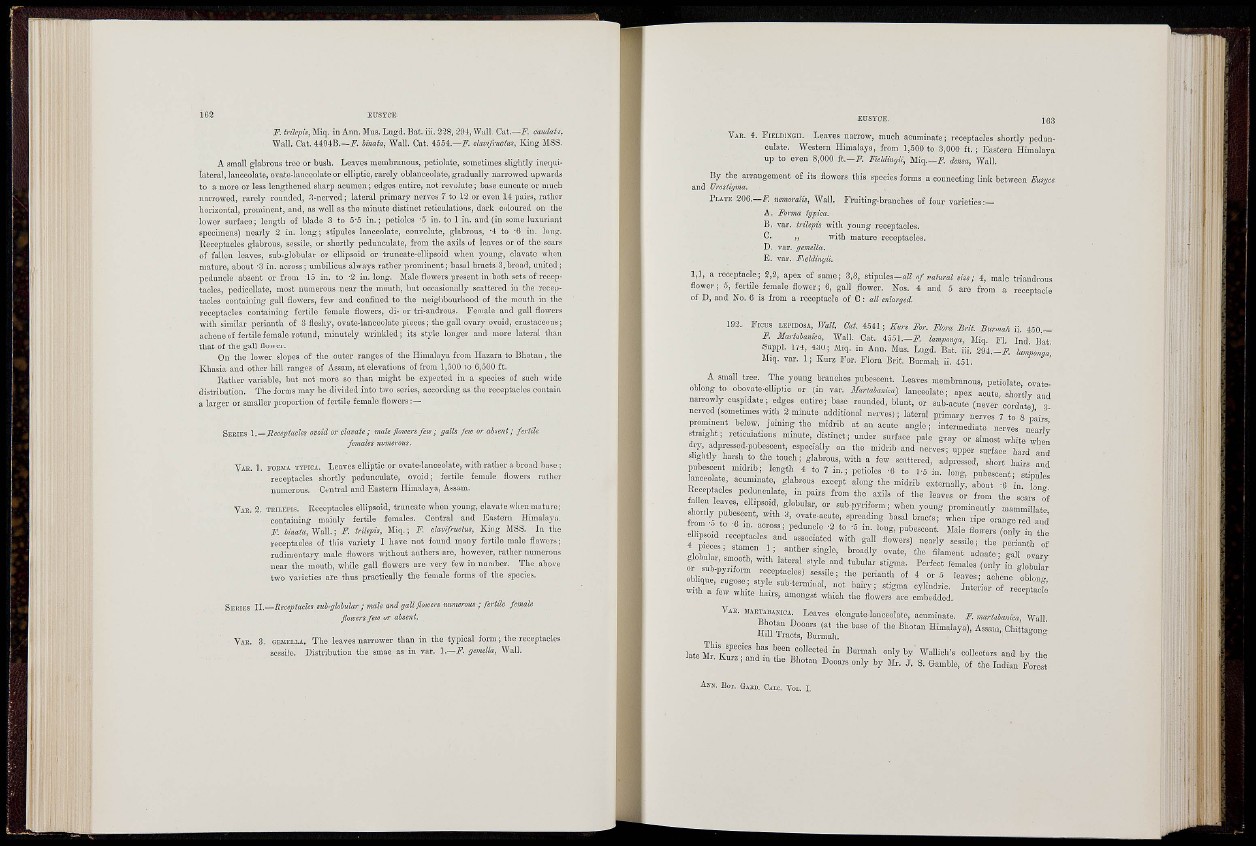
•f ;
F. tnlepis, Miq. in Ann, Mus. Lugd. Bat, iii. 328, ¿94, Wall. Cat.—i'. caiidaU,
Wall. Cat. 4494.B F. Unata, Wall, Cat. 4554,—J", clavfructu.^, King MSS.
A small glabrous tree or bush. Leaves membranous, petiolate, sometimes sliglitly inequilateral,
lanceolate, ovate-Ianeeolate or elliptic, rarely oblanceolate, gradually narrowed upwards
to a more or less lengthened sharp acumen; edges entire, not revoluto; base cuneate or much
narrowed, rarely rounded, •'^-nerved; lateral primary nerves 7 to 12 or even 14 pairs, rather
hoiizoutal, prominent, and, as well as tho minute distinct reticulations, dark coloured on the
lower surface; length of blade 3 to S'O in.; petioles "5 in. to 1 in. and (in some luxuriant
specimens) nearly 2 in. long; stipules lanceolate, coavolute, glabrous, -4 to -6 in. long.
Ecccptacles glabrous, sessile, or shortly pedunculate, from the axils of leaves or of the scars
of fallen leaves, sub-globular or ellipsoid or truncate-ellipsoid when young, clavate whtm
mature, about -3 in. across; umbilicus always rather prominent; basal bracts 3,broad, united ;
pedunclc absent or frour 15 in. to -2 in. long. Male flowers present in both sets of receptacles,
pedicellate, most numerous near the mouth, but occasionally scattered in the receptacles
containing gall flowers, few and confined to the neighbourhood of the mouth in the
rcccptacles containing fertile female flowers, di- or tri-androus. Female and gall flowers
with similar perianth of 3 fleshy, ovate-lanceolate pieces; the gall ovary ovoid, crustaeeous;
achone of fertile female rotund, minutely wrinkled; its style longer and more lateral than
that of the gall flower.
On tho lower slopes of the outer ranges of the Himalaya from Hazara to Bhotan, the
Ivhasia and other hill ranges of Assam, at elevations of from 1,500 10 6,500 ft.
Rather variable, but not more so than might he expected in a species of such wide
distribution. The forms may be divided into two series, according as the receptacles contain
a larger or smaller proportion of fertile female flowers:—
SERIES 'Receptacles ovoid or clavate; male flmvers few; galls few or absent; fertile
females numerous.
VAE. 1. FORMA TTPICA. Lcaves elliptic or ovate-lanceolate, with rather a broad hase ;
receptacles shortly pedunculate, ovoid; fertile female flowers rather
numerous. Central and Eastern Himalaya, Assam.
YAJI. 2. TEILEPIS. Receptacles ellipsoid, truncate when young, clavate when mature;
containing mainly fertile females. Central and Eastern Himalaya.
F. iinaia. Wall.; F. trilepis, Mlq.; F. clavlfructus, King MSS. In the
receptacles of this variety I have not found many fertile male flowers;
rudimentary male flowers without anthers are, however, rather numerous
near the mouth, while gall flowers are very few in number. The above
two varieties are thus practically the female forms oi the species.
SEUIES 11.—Receptacles suh-glohular ; male and gall flowers numerous; fertile female
flowers few or absent.
YAK. 3. GEMELLA. The leaves narrower than in tho typical form; the receptacles
sessile. Distribution the smae as in var. \.—F. gemella, Wall.
EUSYCE. 163
VAR. 4. FIELDINGII. Leaves narrow, much acuminate ; receptacles shortly pedunculate.
Western Himalaya, from 1,500 to 3,000 ft.; Eastern Himalaya
up to even 8,000 f t .—R e l d i n g i i , Miq,—2?. densa, Wall.
By the arrangement of its flowers this species forms a connecting link between Eusijce
and Urosti()ma.
PLATE 206.—f. lumoralü, Wall. Fmiling-braiiches of four Tai-ielies:—
A. Forma iy-pica.
B. var. tnlepis witli yoimg receptacles.
C. „ with mature receptacles.
D. var. gemella.
E. var. Fieldmiiii.
1,1, a reccptade; S,2, apex of Bame; 3,3, stipules-«« «f mlural sia; 4, male triandrous
flower; 5, fertile female flower; 6, gall flower. Nos. 4 and 5 are from a receptacle
of D, and No. 6 is from a receptacle of G : all enlarged.
193. Fious MpiDOsi, Wall. Oat 4-541; Kurz For. Flora Brit. Bur,ml, ii. 4.50 —
F. MarUUniea, Wall. Cat. 4o51.—J. lamfong.j, Miq. FI. Ind Bat
Suppl. 174, 430; Hiq. iu Ann. Mus. Lugd. Bat. ¡¡i. 2 9 4 . _ £ ¡ampo„aa
Miq. var. 1; Km-z For. Flora Brit. Barmah ii. 451.
A small tree. The youug braucles pubescent. Leaves membranous, petiolate, ovateoblong
to obovate-elhptic or (ia var. Marlala.uia) lanceolate; apex acute, sliortlv and
narrowly cuspidate; edges entire; base rounded. Hunt, or sub-acute (never cordate) -i
nerved (sometimes with 2 minute additional nerves); lateral primary nerves 7 to 8 ot"
promment below, joining the midrib at an acute angle; intermediate nerves n„rlZ
straight; reticulations minute, distinct; under smface pale gray or almost white when
dry adpressed-pubescent, especially on the midrib and nerves-; upper surface hard and
slightly hai-sb to the touch; glabrous, with a few scattered, adpr ssed, short bats and
pubescent midrib; length 4 to 7 in. ; petioles -O to l-o in- long, pnbescent s. pu es
anceoate, acm^mate, glabrous except along the midrib exterualty about t i n fot
receptacles pedunculate, iu pair-s from the axils of tbe leaves or from the s^arl S
h e l r t ; f " 3-»uug prominently m a l I t f
fro, 5 r r ' ' b' '«"»; wire,, ripe orange red and
f em o to -6 m- across; peduncle -2 to -5 in. long, pubescent. Kale fiowers (only in the
ellipsoid receptacles and associated with gall flowers, nearly sessile; the ,™fanth of
globulai, smooth, with lateral style and tubular stigma. Pcrfect females (oni; .n globular
or sub-pjr,form receptacles) sessile; the perianth of 4 oro leaves• acLÙo oW
with a few white ba,rs, amongst which tbe flowers are embedded. '
Via. MI,MB-«,OA. Leaves elongate-lanceolate, acuminate. F nart^anica. Wall
Bhotan Dooars (at the base of tbe Bhotan Himalaya), Assam, Chitta^ono;
riiU iracts, Burmah. °
l i m . , and in the Bhotan Dooars only by Mr. J. S. Gamble, of the Indian L e s t
As». Bor. G-UID. Care. Tor. I,